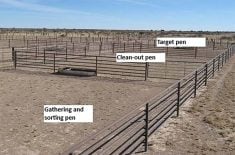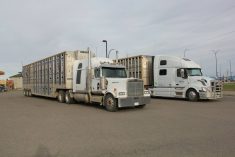A good bovine stomach tube is useful for relieving bloat, administering oral medication or relieving an esophageal obstruction or choke. As well, dehydration is caused by many things and a good stomach tube and pump can address that problem.
Properly maintained equipment and proper restraint make the job easy. The procedure is generally innocuous but things can go wrong.
I hear many stories of producers tubing an animal and having the tube chewed or even swallowed. Sometimes it is a fashioned stomach tube from a garden hose, and while this may be effective in an emergency, it is not the best way to go.
Read Also

Quebec pork company calls for transparency around gene-edited pigs
Quebec-based pork company duBreton is calling for transparency around meats from gene-edited pigs on concerns that a lack of mandatory labelling will confuse consumers, and dilute certification claims. The organic sector is also calling for labelling rules.
I recommend that more producers buy a commercial stomach tube. They come in three sizes but the medium size is suitable for most uses.
The other critical thing is a Fricks speculum, which is basically a smooth pipe placed in the mouth so the animal can chew on it while the stomach tube is passed inside it. This avoids cattle biting the tube and facilitates easy passage.
If the tube is cleaned, disinfected and coiled after each use, it can have many years of life in an operation. Total cost for a good tube and speculum would be a little over $100.
A stomach pump is an additional cost but the good stomach tubes have a flared end so a funnel can be attached and medication or fluids poured into the funnel.
On gas bloat, tubing can be done quickly and the gas relieved, but in cases of frothy bloat, it may only be able to reduce pressure a little. Then administer medication through the tube.
In the old days of more grain overload, we would use a tube to remove as much of the acidic grain slurry as possible and follow it with an antacid mixed in water. With good feeding practices, that is rarely necessary anymore but many overloaded animals were saved with medication administered by a stomach tube.
In choking cases, from potatoes in cattle feed or dry feed in horses, the stomach tube is our main instrument. For other impactions, laxatives such as magnesium oxide or mineral oil and blood medicines are given to loosen the impaction.
I am not a fan of mineral oil because it has no taste and thus can be aspirated. It is difficult to clean from equipment but is still effective as a laxative.
With all these uses, decent restraint in a chute is preferred. I work on some show cattle and we can often tube them where they stand at halter. Know your limits and make sure you are safe.
When tubing really sick cattle, make sure to smell the tube for rumen contents. Also ensure you can feel the tube going down the esophagus to make sure it’s in the right place.
In the absence of a big balling gun, the Fricks speculum can be used to administer boluses or rumen magnets.
Most of us have had a chronic bloater and they can almost be trained to open their mouth for tubing because relief of pressure occurs.
If using a tube to pour or pump in fluids, remember that electrolytes can be given to older cattle, not just calves.
Bigger animals require more fluids for the same degree of dehydration. For example, if you think an animal is five per cent dehydrated and weighs 500 pounds, that computes to about 2.5 gallons or about 10 litres.
Remember that illness can be transferred between animals so wash the tube thoroughly and run a bit of Virkon disinfectant through it before putting it away.
The commercially made stomach tubes are very smooth and yet stiff enough to easily pass down. The last thing one wants is abrasions in the mouth, throat or down the esophagus. We definitely want to be gentle in these sensitive areas.
It is great insurance to have a good stomach tube and speculum on your operation and be trained in how to use it.

















